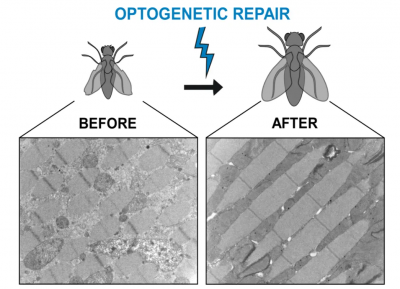EMBL Australia group leader Dr Harald Janovjak and his team of researchers at the Australian Regenerative Medicine Institute (ARMI) have begun to demonstrate the potential of a new method to treat Parkinson’s disease.
The research, led by ARMI and EMBL Australia group leader Dr Harald Janovjak in collaboration with colleagues in Germany and Austria, was published in PLOS Genetics today.
“In Parkinson’s disease, and indeed many neurodegenerative diseases, specific and very important cells in the brain die,” Dr Janovjak explained.
“Two current major strategies to counter this cell death involve injecting growth factors or growth factor gene therapy. However, these methods can lead to the undesired activation of other cells or induce non-natural or permanent responses in the brain. As such, there is an urgent need to explore alternative strategies that can help keep specific brain cells alive while minimising any side effects.”

Dr Janovjak and his team of scientists have shown that optogenetics may hold the key.
Optogenetics is a rapidly evolving research technology, with an increasing number of highly-cited publications, licensed patents and now two clinical trials employing the tool in some way. A technique that uses light to control cells in tissue, optogenetics has many applications and holds great promise in both research and clinical settings.
In this new publication, the research team has demonstrated that the optogenetic-mediated activation of a key signalling pathway, the PI3K proliferative signalling pathway, was viable and effective in a genetic model of Parkinson’s disease. By turning on this pathway, cells can be ‘rescued’ from the hallmarks of neurodegeneration.
“We have genetically altered a specific receptor so that it is activated by light,” Dr Janovjak said.
“Upon blue-light stimulation, this receptor robustly induces a growth response in isolated cells and in the Drosophila fly. This led to the suppression of mitochondrial defects, tissue degeneration and behavioural deficits, all hallmarks of juvenile Parkinson’s disease in this genetic model.”

This research provides proof-of-concept for the potential mechanisms and use of optogenetics in treating Parkinson’s disease. Critically, this method is precise, being cell type-specific and reversible. As such, it has the potential to overcome some of the limitations of the current strategies.
“We just made it through the first few rounds of the boxing match. We need to validate this technology in more models until we can trial it in humans,” Dr Janovjak said.
“This paper is a great start as we have demonstrated the potential this strategy has to interfere with degeneration and may open new avenues towards tissue repair in other diseases beyond Parkinson’s disease.”
Read the full paper: Ingles-Prieto A, Furthmann N, Crossman SH, Tichy AM, Hoyer N, et al. (2021) Optogenetic delivery of trophic signals in a genetic model of Parkinson’s disease. PLOS Genetics 17(4): e1009479. https://doi.org/10.1371/journal.pgen.1009479